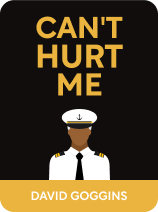

This article is an excerpt from the Shortform book guide to "Can't Hurt Me" by David Goggins. Shortform has the world's best summaries and analyses of books you should be reading.
Like this article? Sign up for a free trial here .
What’s David Goggins’s advice from Can’t Hurt Me? What can you do to apply the lessons of the book to your life?
In Can’t Hurt Me, former Navy SEAL David Goggins describes his transformation from someone who let his circumstances control him to someone who proactively seeks greatness by tackling new challenges. He thinks everyone can work to cultivate a drive for self-improvement in order to overcome obstacles and reach their goals.
Here’s David Goggins’s advice on how to reach any goal.
Confront Obstacles
David Goggins’s advice is to begin confronting the obstacles you currently face. Take stock of the circumstances that have shaped your life, past and present:
- Start a journal. Paper or digital (on your laptop or phone) are both fine.
- List all of the difficult things you’ve faced or face in life. Ask yourself the following questions to jog your memory:
- What difficult circumstances did you face growing up? For example, you might have faced abuse or felt low self-esteem. Or, did you grow up without major challenges and therefore fail to learn to push outside your comfort zone?
- What kinds of challenges do you face now? For example, maybe a boss is limiting your progress at work, or you’re sabotaging yourself in some way from moving forward.
Make an Accountability Mirror
An “accountability mirror” helps you break your goals and dreams into manageable steps and offers a visible reminder of what you’re working toward. It’s called an accountability mirror because it helps you hold yourself accountable for taking the steps necessary to achieve your goals.
Using Post-it notes or paper (rather than digital means), follow these steps:
- Write down all of your insecurities. Own your insecurities and use them as an opportunity to improve yourself.
- Write down all of your goals and dreams. Break them into small, specific steps, written on separate Post-it notes. Stick all your notes on the mirror. Hold yourself to working on them each day. The insecurities could inspire your goals, but don’t have to be related.
Get Uncomfortable
To push yourself toward your goals, learn to do things that make you uncomfortable. They can be related to your goals, but don’t have to be—building your tolerance for discomfort will prevent it from holding you back.
Here’s how to practice:
- Using your journal, write down things that make you uncomfortable or that you dislike doing. Or, consider writing down things you aren’t doing, but should be.
- Pick one and try doing it. Then, do it regularly.
- Encourage yourself to do something every day that you don’t like. Once something gets easier, make it more challenging.
Best Your Opponents
Here’s how to use your feelings about your opponent to your advantage:
- Identify a challenge or competitive situation you face. For example, maybe you’re struggling to excel at work or get a good grade in math class.
- Identify the opponent you face in that situation. Maybe you’re struggling at work because your boss insists on micromanaging your every move, or maybe you feel like your math teacher doesn’t believe in you.
- Choose a project or other task you can do to showcase your skills. It could be creating a stellar proposal for work or getting a perfect score on an exam.
Take the negative energy you have toward the obstacle or opponent and channel it to excel in your project. If you need to improve your skills to succeed, you might need to do things like studying more or working out outside of practice. Your ultimate goal is to amaze your opponent and earn their respect by vastly exceeding their expectations.
Visualize Success
Practice visualizing your obstacles and successes with these two steps:
- Visualize a challenge or obstacle you need to overcome. Think about what it will look like and feel like when you do.
- Anticipate difficulty. Think about the obstacles you may face ahead of time and develop a plan to address them.
Build Your Cookie Jar
Here’s how to build your own cookie jar:
- Use your journal to write down your major life victories. Examples include exceeding a sales goal, running a half marathon, or convincing the city council to fund homelessness services.
- Write down all of the obstacles you’ve overcome, too. Examples include managing obsessive compulsive disorder, stopping smoking, or improving your relationship with your parents.
- As you work toward your goals, draw on this list to help you when you want to quit.
Manage Your Governor
To learn to push past your natural stopping point, try these steps:
- Go as far as you naturally feel you can. For example, maybe you can run for 15 minutes.
- Once you think you’re at your max, coax yourself to go a bit further. Assess if you actually have energy to go further and talk to yourself about your specific next steps. For example, if you’ve already run 15 minutes and desperately want to stop, try to go another 2 minutes.
Manage Your Time
Do this challenge over three weeks:
- In the first week, make detailed notes about how you spend each 15-30 minute chunk of your day. Note things like how much time you spend on your lunch break, how long your commute is, and whether you’re working without interruption or trying to multitask. Notice when you spend time that could be put toward working on your goals instead.
- For the second week, schedule out your time. Decide what you’re going to do with each fifteen- to thirty-minute chunk of time in your day. This includes exercise and rest. Some activities will require multiple chunks of time. Just make sure you’re not trying to squeeze multiple tasks into the same chunk—focus on one activity at a time. Continue taking notes about how you spend your time.
- For the third week, refine your schedule further based on your experience in the first two weeks. Ideally, you’ve arrived at a schedule that provides the maximum amount of time to do your important activities.
Learn From Failure
Learn to reflect on your failure with these steps:
- Think of a recent failure.
- Using a journal–on paper this time, if it isn’t already—ask the following questions to help you evaluate the failure:
- What did you do well as you prepared for and executed the failure?
- How did you handle the failure?
- How did the failure affect your relationships with others?
- How did it affect your life?
- What could you have done differently?
- (Optional) As soon as you can, schedule a time to make another attempt at the thing you failed at. If for some reason you can’t attempt the experience again, just do steps 1-2

———End of Preview———
Like what you just read? Read the rest of the world's best book summary and analysis of David Goggins's "Can't Hurt Me" at Shortform .
Here's what you'll find in our full Can't Hurt Me summary :
- What a Navy SEAL says about pushing yourself to achieve greatness
- How to put in more effort to realize your potential
- The 10 challenges you can take on to reach your goals






